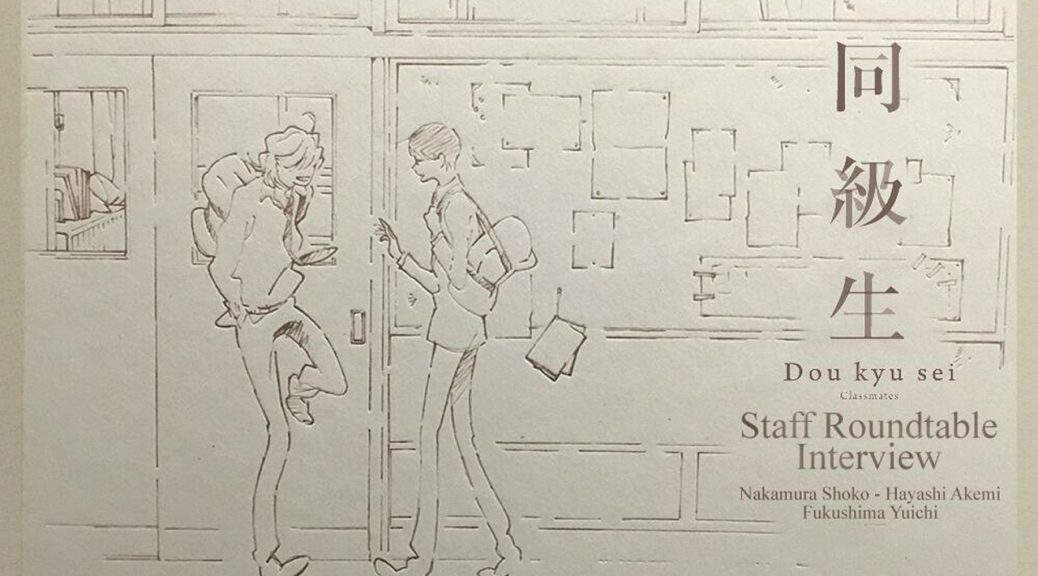
Doukyuusei Staff Roundtable: Shouko Nakamura x Akemi Hayashi x Yuuichi Fukushima
Right before its second anniversary and to celebrate its special screening on Valentine’s Day, we bring you the translation of a lengthy conversation between the main figures behind the Doukyuusei anime film. Their insight on everything we could see on the screen, as well as the struggles happening behind the scenes, should be a delightful treat for all fans. And if you haven’t seen the movie yet, this is another excuse to get around to it!
Shouko Nakamura – Director
Akemi Hayashi – Character Designer, Chief Animation DirectorChief Animation Director (総作画監督, Sou Sakuga Kantoku): Often an overall credit that tends to be in the hands of the character designer, though as of late messy projects with multiple Chief ADs have increased in number; moreso than the regular animation directors, their job is to ensure the characters look like they're supposed to. Consistency is their goal, which they will enforce as much as they want (and can).
Yuuichi Fukushima – Animation Producer
Originally published within Doukyuusei’s Director’s Corrections Collection. Translated by Good Haro.
––I hear you were the first one offered the project, Ms. Nakamura.
Nakamura: Yes. I always thought the atmosphere of Asumiko Nakamura’s stories and art would make for interesting anime adaptations. I thought it would be a good opportunity to do some things I don’t often get the chance to, genre consideration included. It seemed like an interesting project so I said I’d be happy to take the job if they would have me.
––And then Nakamura was the one to approach you, Ms. Hayashi, correct?
Hayashi: That’s right. I could never forget it. We were in a cafe on the first floor of Kichijoji department store. Nakamura and I were enjoying a light meal, and that’s when she pulled out the manga and broached the subject.
“What do you think about designing for this?” She told me. And I was like, “Huh? Are you directing?” and she said yes.
Nakamura: Wow, you even remembered the location.
Hayashi: I remember it like it was yesterday.
Fukushima: You have a good memory for that sort of thing, don’t you?
Hayashi: Well, it really left an impression, you know? I remember it being a cold day in December (2013) too. …The first thing she asked me to do was character designs for Doukyuusei and storyboards for chapter three of the manga, “His First”, if I remember correctly.
Nakamura: Yeah, that’s it. Unfortunately, “His First” ended up being cut for time.

––When did you get involved, Mr. Fukushima?
Fukushima: I was the last of this group here to get on board. I threw my hat in the ring when the question of who would produce it came up after they’d decided to make the movie in-house.
Nakamura: I remember Fukushima coming to me once and asking if I minded working with him.
Fukushima: Yeah, I wanted to get Nakamura’s blessing (laugh)––“Are you sure you’re okay with working with me?”
Everyone: (laugh)
––The first thing that really grabs your attention about the movie is just how well the character designs capture the atmosphere of the original manga.
Hayashi: Doukyuusei is actually the title of the first volume in the series. It’s really been quite a while since it was released, so (Asumiko) Nakamura’s art style has shifted a bit since then. So, I read up through the most recent installment of the series, O.B., and went hunting for the point in the manga’s run with designs that had the perfect balance for animation. The director had requested that I go for the style of one of the short stories in Graduation Album (the story “One More”).
Nakamura: Personally, I thought that balance would be the easiest thing to screw up in animation. Even the lines of the manga have gotten much more streamlined with much starker silhouettes. I also made a collection of expressions from the original manga that I thought would be useful points of reference and gave them to Hayashi.
Hayashi: Once I got that set of instructions, I endeavored to create well-balanced designs that would be fitting of the production using bits and pieces not just from Doukyuusei itself, but from Sotsugyousei and other points in the series.

––Were there any requests from the original author regarding the character designs?
Hayashi: When she was approving Kusakabe’s hair, she asked me to reference O.B. I was a little surprised by that request. As the most recent installment in the series, O.B. hadn’t really been my main focus for reference. But I think from her perspective, as the installment with art closest to her current style, O.B. must have felt the most “right” to her.
––Was Kusakabe’s hair that complicated?
Hayashi: It sure was. It’s the kind of design where the silhouette is really critical, so it was always on my mind while I was working. But his hair is also a golden blond, which is an expansive color, so whenever I’d draw the round top of his head properly – just like I would with Sajo – and then draw his hair on top of that there’d be so much volume his head would end up looking huge. Though, Kusakabe is also pretty tall, so there were some points where I’d correct even some of my own key animationKey Animation (原画, genga): These artists draw the pivotal moments within the animation, basically defining the motion without actually completing the cut. The anime industry is known for allowing these individual artists lots of room to express their own style. when working through cuts as supervisor to tone it down some so he’d look more balanced with Sajo when they were standing side-by-side. There was actually a point where exchanging letters about his hairstyle was getting me nowhere, so ultimately I ended up asking (Asumiko) Nakamura to correct the design for me! (laugh)
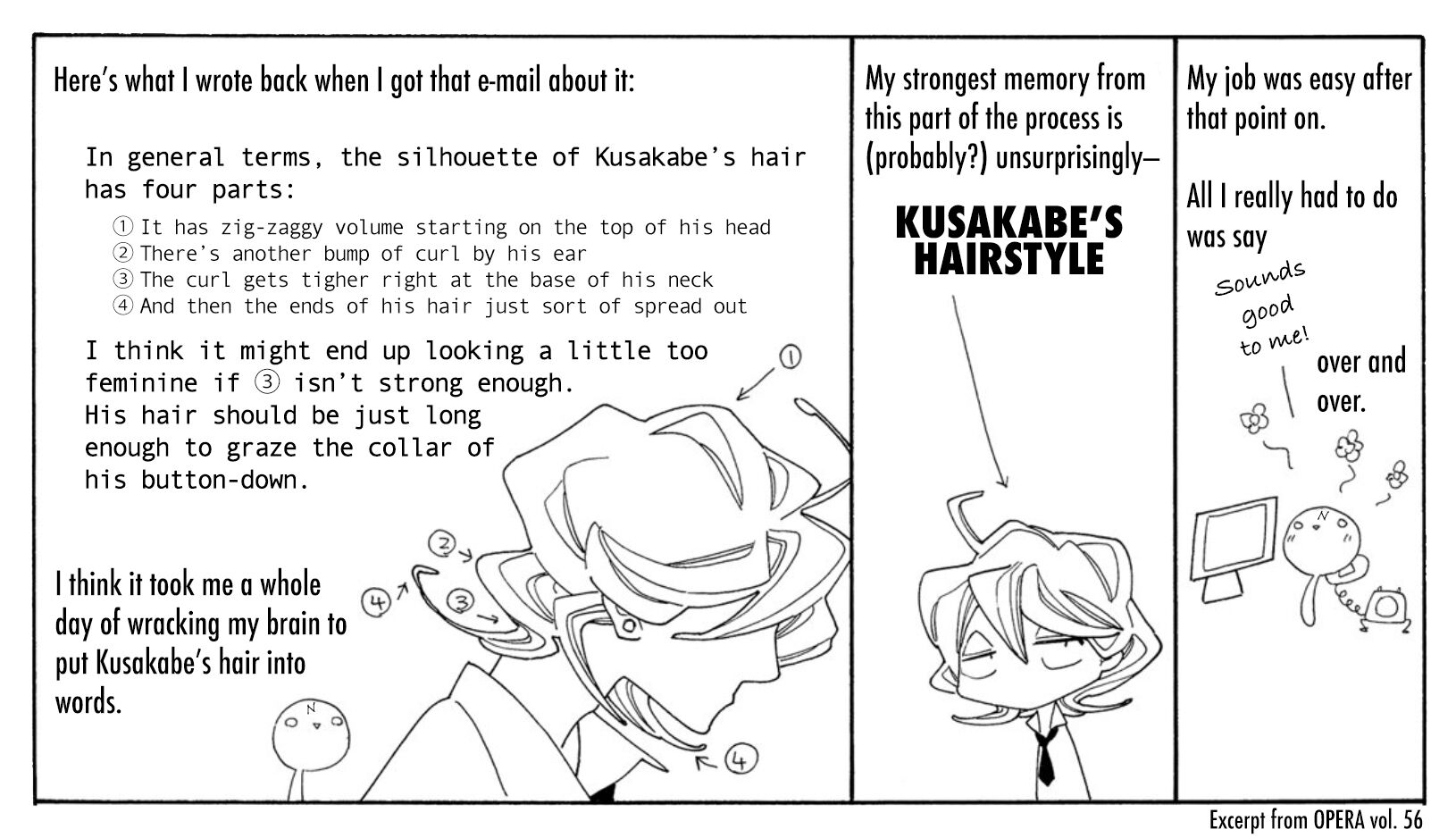
––Actually, in volume 56 of OPERA, Ms. (Asumiko) Nakamura mentioned how she’d corrected Kusakabe’s hair in the feature “Until the Doukyuusei Anime is Finished”.
Hayashi: Yep, she sure did.
Nakamura: The hair was hard enough, but getting the facial proportions right was difficult too. It’s pretty common to draw male characters with longer faces – Harasen in particular leans more toward that convention. But in the mangaka’s art, both the silhouettes of her heads and the contours of her faces have a really particular round, almost perfectly circular, proportion to them, so I took special care to not lean too hard on the trope of men with longer faces.
Hayashi: Speaking of hard, Harasen’s hair was pretty difficult too~
Nakamura: I thought Harasen would be the most difficult. Speaking of whom, is he supposed to have a perm?
Hayashi: Yeah, he totally does. His hair is totally smooth in the flashbacks to his school days. It made me go, “oh my god he totally permed his hair!” (laugh).
Nakamura: You can totally see some traces of his hair’s natural texture in how relatively straight his bangs are if you’re looking for it (laugh). His hair looks like a bit of a mix of textures.
Hayashi: If I didn’t take care not to overdo it with the back of Harasen’s head, he’d have a totally different silhouette.
Nakamura: Oh, I can see that.
Hayashi: Sajo on the other hand has good posture and a simple hairstyle, so even if you take a more sort of typical anime-like approach with his design, he comes out looking more or less like he should. Actually, I found the background students a much more difficult subject to approach – how should I draw them to make them look like they belonged in Doukyuusei?
Fukushima: Um, so I’ve had this question I’ve been dying to ask you two for ages – was there ever anything you really had a hard time with while you were working? Like that just made you think you couldn’t draw it and had to keep starting over?
Nakamura: Huh? What do you mean exactly?
Hayashi: Are you asking about the drawing process specifically?
Fukushima: Yes. I’m sorry, I probably phrased it strangely (laugh), but as a producer I don’t see the entire process. I just get to see the end results of a day’s work and it all looks amazing to me.
Nakamura & Hayashi: (laugh)
Fukushima: So that’s why I always wanted to ask you about it. I guess I really mean to ask if there was anything you really had to struggle with while drawing?
Nakamura: As far as drawing technique goes, Hayashi doesn’t really do a lot of rough sketching.
Hayashi: Well, it’s more like I try to do as little rough work as possible during actual production.
Nakamura: I’m jealous. She’s so good at it, it makes me feel like a total moron.
Hayashi: I think we just have different approaches to things. For me, I just hate breaking a nice clean pencil line and don’t like having to make a clean copy once I finish a drawing either. I feel like it ends up ruining the drawing… I always want to get the image I have in my head out onto the page in one shot. Of course, there are times when I have to keep erasing and redrawing parts if something doesn’t turn out the way it was in my head, but my goal is generally to get out nice lines in one shot that just feel right. So that’s always something I struggle with.
Nakamura: I guess you could say drawing’s fraught with struggles.

––So what was actual production like?
Hayashi: The first step is the director checking the layoutsLayouts (レイアウト): The drawings where animation is actually born; they expand the usually simple visual ideas from the storyboard into the actual skeleton of animation, detailing both the work of the key animator and the background artists., but even at that stage, we had already made corrections to most major points. We had a lot of time in the beginning, so we could be very thorough (laugh).
Nakamura: We really did. I definitely spent a lot of time looking over several scenes in the first chapter, “Summer”.
Hayashi: Yeah, so we’d have like 20 corrections for any given cut as a result. As animation director, it was enough to make me wonder how far I should be taking corrections. It’s just that, when I start my work as animation director, I’m doing my best to figure out the right approach as I go, and I was drawing enough corrections to make me ask myself if, ultimately, it made sense to be making so many. On one hand I think it’s much better to allow the key animators to do their thing, but when I have time available to me, I always want to make little adjustments here and there. And I found things that helped attune me to the details and flow of this particular production while I was trying to find that right balance.
Nakamura: I make corrections to the key animationKey Animation (原画, genga): These artists draw the pivotal moments within the animation, basically defining the motion without actually completing the cut. The anime industry is known for allowing these individual artists lots of room to express their own style. too, but I’m really most drawn to the impression the animators’ drawings leave with me. If an animator is good at creating an atmosphere, the nuance of the scene and that feel end up shining through even if I were to correct every single frame of a cut.
––There’s something really charming about how the character designs become abbreviated in long shots.
Hayashi: I guess I could say that it’s about being economical from an animation standpoint (laugh). That certainly is a factor, but it’s also part of the stylistic character of the source material.
Fukushima: Viewers definitely do ask about the short hand designs in long shots a lot.
Hayashi: What I always hear is that it’s just not drawing the eyes, but it’s not really as simple as just not drawing eyes on the characters in the back of a given shot, sometimes they get omitted even with characters in the foreground. Someone once told me it’s something that requires a delicate hand.
Nakamura: Personally, it never seemed like that big a deal to me, but thinking on it a little more, I guess I never really thought on it all that deeply either.
Hayashi: It’s not something I ever worried about all that much either. The background characters in the original manga are often drawn without faces, so it wasn’t really something we had to wrestle with too much on this project.
Nakamura: I don’t feel like it’s imperative to fill in all the spots that were rendered with less detail in the original comic when adapting for animation. There are times where filling in every little detail in the image can destroy the atmosphere. The shorthand designs give the original a particular flavor, so I work with the goal of bringing that over effectively in anime form.
––I think the sort of poetic mood and pacing of the gags are where this piece really shines. The style even shifts to a more manga-like look at times to fit the tone.
Hayashi: Like when Kusakabe hit Harasen in chapter 2, “Autumn”?
Nakamura: The presentation of that scene ended up being extremely manga-ish, so part of me wasn’t entirely confident about that choice. At first when I was drawing the storyboardStoryboard (絵コンテ, ekonte): The blueprints of animation. A series of usually simple drawings serving as anime's visual script, drawn on special sheets with fields for the animation cut number, notes for the staff and the matching lines of dialogue., I’d drawn it with an almost Tom & Jerry style reaction with his eyes popping out of his head and thought about including it. I ended up dropping the idea though since it seemed way too over the top (laugh).
Fukushima: Not gonna lie, I kinda would’ve liked to see that (laugh).
Nakamura: I’ve always felt that the author’s work had a sort of cartoony quality to it. If we’d endeavored to stay away from manga style conventions as best as we could, I think it would’ve been hard to translate the charm of her style.
––I was pretty impressed that you included the bit at the end of chapter 2 where Harasen discovers that he’s bleeding and his little exchange with Hashimoto.
Hayashi: It just felt like it fit. I think that little scene was added for the collected print edition of the manga, wasn’t it?
Nakamura: I think so. The original run just ended on that frame of Harasen freaking out when he noticed the blood. The conversation with Hashimoto was just a little rough thing on the following page connecting chapters.
Fukushima: Actually, I didn’t even notice it at first when I was reading the storyboards. Later, I started to wonder where that bit came from so I went back and read the source material again and found it (laugh). I guess I hadn’t read it very carefully the first time.
Nakamura: That wasn’t the only cut where we included something like that either. We tried to throw in little nods to the original manga with fun background characters and little lines here and there. But I thought Hashimoto in particular was cute, so I wanted to include him.
Hayashi: Yeah, we were even joking around at the start about making a figure of him as part of a “Teacher Figures” series. It was just a joke of course.
Everyone: (laugh)
Hayashi: Even in the original, the teachers just got more and more stylized as the series went on and they kept getting cuter.
Fukushima: And a lot of them were bald too (laugh).
Hayashi: That’s why you see all those shiny bald heads in the scene in the gym (laugh). With that overhead shot you can see everything.
Nakamura: No need to draw hair!
Fukushima: They certainly were showing a lot of skin.
Hayashi: We were joking about how eventually Harasen’s going to lose his hair too (laugh).
Nakamura: Hahaha. Harasen’s the only young teacher at that school, isn’t he?
Hayashi: But I think there are some teachers who are younger than they look.
Nakamura: I still think Hashimoto’s way younger than you’d think. Like mid-40s or something.
Fukushima: Are you serious?!
Nakamura: I mean, it’s not like I know for sure or anything (laugh). That’s just the impression I got from Sotsugyousei.
Hayashi: Yeah. The classics teacher and the others seem much older to me.
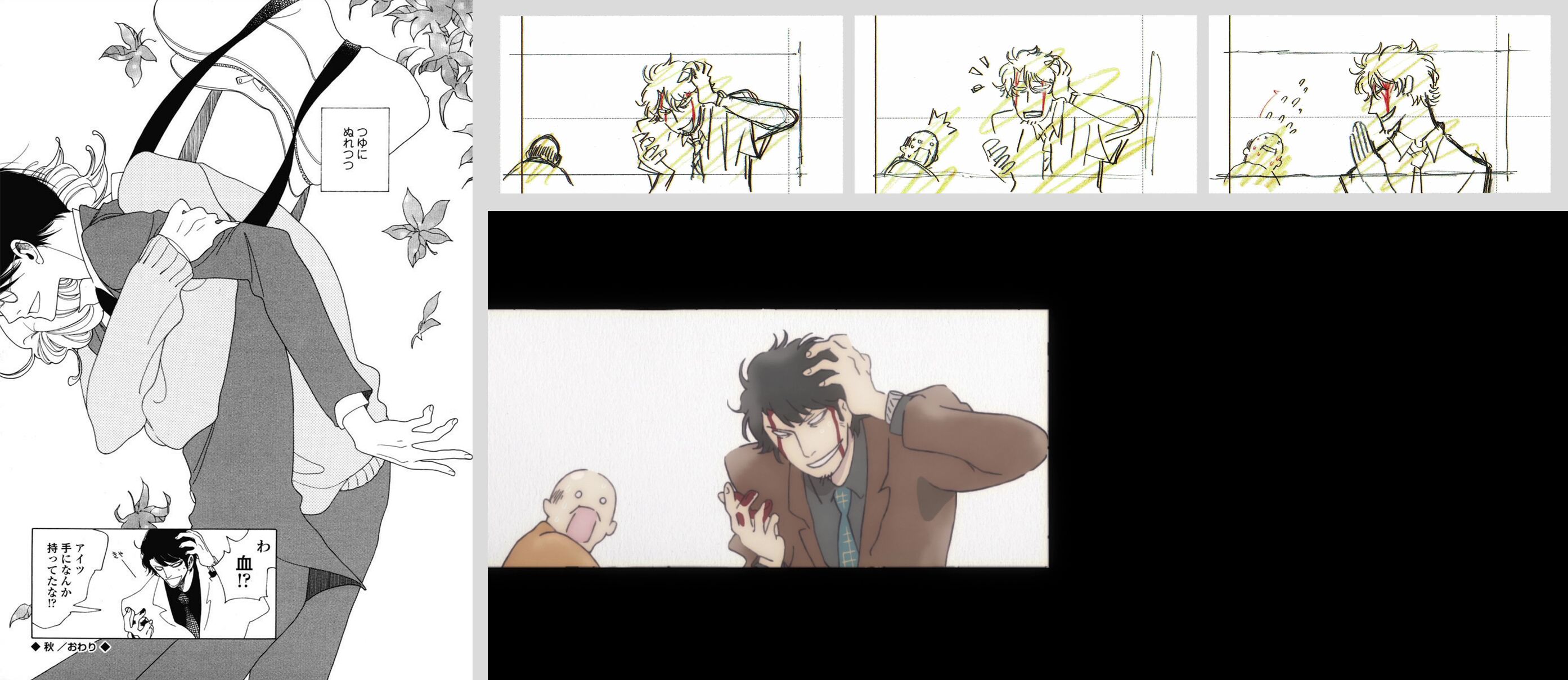
––Was there a moment during production that made you feel like things were really coming together?
Fukushima: For me I think it was when we finished the first trailer we released. Nakamura and Hayashi had drawn all key animationKey Animation (原画, genga): These artists draw the pivotal moments within the animation, basically defining the motion without actually completing the cut. The anime industry is known for allowing these individual artists lots of room to express their own style. that, and art directorArt Director (美術監督, bijutsu kantoku): The person in charge of the background art for the series. They draw many artboards that once approved by the series director serve as reference for the backgrounds throughout the series. Coordination within the art department is a must – setting and color designers must work together to craft a coherent world. Chieko Nakamura had painted all the backgrounds, but it wasn’t until that trailer was finished that it really hit me, “Oh, so this is what we’re making!”
Nakamura: It took you that long?! (laugh)
Fukushima: (laugh) Well, that was just when it really clicked for me. Like there was that scene you drew, Hayashi, where Kusakabe’s walking down the hall, right? The one where he’s like stomping along (See Key AnimationKey Animation (原画, genga): These artists draw the pivotal moments within the animation, basically defining the motion without actually completing the cut. The anime industry is known for allowing these individual artists lots of room to express their own style. Collection pages 4-5 below).
Hayashi: Yes, I know the one.
Fukushima: That’s just where I could finally see it – “Oh, this is how the characters move!” The anime productions I’ve been in charge of lately don’t feature a lot of shorthand, so when I look at Doukyuusei, I’m impressed at how even still scenes or setting shots really hold your attention and have so much meaning packed into them. So when I saw the trailer for the first time, it just really drove it home that we were on the right track to make something amazing. After that I was already wondering how long production would take.
Hayashi: You were wondering whether we would be able to keep it up to the end?
Fukushima: Yeah. Nakamura and you key animated the whole trailer so it was extremely refined. But I had to wonder how far the two of you would be able to go with it for the full 60 minutes.
––So you sort of used the trailer almost like a pilot for the rest of the film?
Nakamura: Exactly. We were still figuring out the look and feel of things while we were working on the trailer and settled on it toward the end (of making the trailer).
Fukushima: You ended up trying a number of different colors for Kusakabe’s hair too, right?
Nakamura: That’s right. That’s why the colors look a little different in the trailer compared to the final film.
Hayashi: We still hadn’t completely settled on how we wanted to handle hair highlights during the trailer either. Though I wanted to use gradients from the start so that’s why we put those in. I never would have thought that’s how our extremely long journey would have begun though (laugh).
Nakamura: (laugh).
––Was there anything that particularly resonated with you, Ms. Hayashi?
Hayashi: You mean with the first trailer? There was that running scene, and the colors were just so pretty, plus the backgrounds were amazing too. From an animation perspective, I remember feeling that the more cartoony stuff turned out really well and vaguely thinking that maybe it really was going to turn out after all. Beyond that, I think this is a little different from what you’re asking for, but that scene in the guidance counseling room between Sajo and Harasen in the theatrical trailer left a bit of an impression on me. I remember it really making me think that Harasen must absolutely reek of cigarettes!
Nakamura: I had the color department lower the saturation on all of the shots in “Autumn” except for the very end when it lightens up again, but I think that fit particularly well with that scene with Harasen.
Hayashi: Makes sense. During rush (checking the movie data after it comes back from photographyPhotography (撮影, Satsuei): The marriage of elements produced by different departments into a finished picture, involving filtering to make it more harmonious. A name inherited from the past, when cameras were actually used during this process. to make sure there are no issues with it), I was really impressed by how I could practically smell the cigarette smoke lingering on him in that scene. …Now the worst part was when I was drawing and drawing and the layoutsLayouts (レイアウト): The drawings where animation is actually born; they expand the usually simple visual ideas from the storyboard into the actual skeleton of animation, detailing both the work of the key animator and the background artists. just didn’t seem to end…
Nakamura: …Oh, was it that bad?
Hayashi: I think at the time the person who was in the worst shape was Fukushima, since the pile of cuts behind me and Nakamura never got smaller! (laugh)
Fukushima: The volume was pretty steady all the way to the end, wasn’t it? But I never felt like throwing in the towel. I was just always wondering when it was going to end (laugh).
Nakamura: I remember Fukushima asking me how much longer we’d be doing layout checks for and I’d answer, “just one more week” – I think we did this about ten times?
Hayashi: Production-wise, we were just taking the number of cuts that still needed work and dividing them by the remaining days we had. I don’t know how many times I looked at the target for a day and went, “yeah, that’s not happening.”
Fukushima: Even knowing where Nakamura and Hayashi wanted to finish on a given day, I could usually tell when things weren’t actually going to make it (laugh), so I always had to be thinking about ways to counterbalance the workload. But even once I’d compensated for something, I still had to keep a close eye on the status of things. I think this production was the most numbers-intensive (in terms of scheduling) I’ve ever worked on.
Nakamura: Really? I always thought you were just that detail-oriented (laugh). You’d always be calling me over to ask how the numbers looked.
Hayashi: There was a lot of checking over spreadsheets.
Nakamura: See, that’s why I almost felt like I could relax since Fukushima was taking such good care of things in that department (laugh).
Fukushima: (laugh)
Hayashi: The one thing I’ll never forget is something Fukushima said during all-rush (watching all the cuts in sequential order to check their status). He came in on a break and sat down and rested his arms on the desk before slowly turning to me and saying, “Hayashi… I think we’ve done it.” (laugh)
Fukushima: Personally, I’ve kind of always felt that once you get to the color stage, you’ve pretty much won.
Hayashi: Mister Producer, is that really something you should be saying?! (laugh)
Fukushima: It just makes me feel like we’ve made it.
Nakamura: How many times have I heard that now?
Fukushima: Look, it just makes me feel like we have nothing to worry about after we get all the color in. The rest is just like, “you guys can handle the rest, fix the stuff you want fixed.”
Hayashi: It is fun to see the quiet excitement (when you get to that stage).
––Let me ask you the same thing, Ms. Nakamura, was there any moment that particularly resonated you?
Nakamura: I was really overwhelmed when we finished the first trailer too. I was so satisfied with what we’d put together I was almost happy enough to leave it at that.
Everyone: (laugh)
Fukushima: More seriously, it really does make you feel like you’ve finished something.
Nakamura: We made three trailers for Doukyuusei, and when we finished each of them it felt like a big accomplishment. Fukushima would always say, “Alright, now we just have to do that 60 more times! Then we’ll have a movie!” (laugh)
––So everything was moving according to your plans when you were producing the trailers?
Nakamura: Oh no, we didn’t have a concrete image for the movie yet at that point. We knew each of the elements were great, but it wasn’t until we saw them all together on screen that it started to feel real. Of course on the other hand I was stuck in endless layout hell just like Hayashi, which was pretty tough.
Hayashi: Typically things go straight to the director first when they’re turned in, but we had so many different types of people on layout and key animationKey Animation (原画, genga): These artists draw the pivotal moments within the animation, basically defining the motion without actually completing the cut. The anime industry is known for allowing these individual artists lots of room to express their own style. that both Nakamura and I would adjust our corrections to each staffer while we checked things over, so it was really a daunting amount of work (laugh).
––How did recording go?
Fukushima: I think the one thing everyone really remembers from the dub session was Sajo’s “I won’t!” from “Autumn”.
Hayashi: The way (Kenji) Nojima said that line was just too cute, everyone couldn’t stop talking about it. Like holy shit guys (laugh).
Fukushima: Yeah. I wasn’t in the booth at the time, but I was watching with (Hiroshi) Kamiya’s manager and the sound engineer. All three of us guys who saw it were like, “that was pretty, like, I mean, holy shit…” (laugh). Our conversation went something something like – “Man, I think I could totally go for that.” “Go for what?!” And that’s when we were all convinced we were making something really outrageous. (laugh)
Everyone: (laugh)
Nakamura: That line had some real punch to it. Both the people who were there observing and the people who heard the recording later were really impressed by it.
Hayashi: And then we used it in the theatrical trailer and it seemed to really stick with the women in the audience. I think we made the right choice using it in the advertising.
––I heard you went out of your way to record sound effects just for the movie.
Fukushima: We wanted to use authentic sounds for the foley and we got permission to do it.
Nakamura: I asked if we could go to an actual all boys school to record the background chatter and environmental noises and whatnot. I was also kind of particular about getting Kusakabe and Sajo’s footsteps to sound different. Like, Kusakabe doesn’t put his school shoes on all the way, so his steps sound different.
Fukushima: That was something that really impressed me during the preview. It really felt like a “real” movie.
Everyone: (laugh)
Nakamura: It really does though. I was pretty excited when we were working on the foley since it made everything sound so cinematic.
Hayashi: It probably helps that you’re watching the footage on a big screen while you’re working for that. That reminds me though, just before we started on foley, (Yusuke) Watanabe, the sound engineer, mentioned that he had deliberately left out any background sound in the cut in chapter 3, “A Complex Fool and a Simplex Fool”, where Kusakabe says, “Sajo, you’re my No. 1” (laugh). Since that scene hinges entirely on the actor’s delivery of the line.
Nakamura: Wait, that was Watanabe, not Fujita? (laugh)
Hayashi: We just happened to be in the entrance to the booth at the same time and he sounded very proud of himself. I remember being a little shocked when I watched the preview and there really was no sound other than the line! (laugh)
Fukushima: Letting the image speak for itself.
Hayashi: Kusakabe already looks way too cool in that shot as it is, but just letting the line stand on its own amps up his charm even more.
––How did you feel when you finished the film?
Fukushima: The director, designer, and art directorArt Director (美術監督, bijutsu kantoku): The person in charge of the background art for the series. They draw many artboards that once approved by the series director serve as reference for the backgrounds throughout the series. Coordination within the art department is a must – setting and color designers must work together to craft a coherent world. didn’t just want to work together, but make something they could all be proud of. Now that it’s actually done, I think it was a lot of fun. We got all sorts of people involved in the production – I’m including the key animators in there – and I think the thing that makes me happiest about the project is that we managed to make such a good film with such a varied team.
Hayashi: It was the first project I’d gotten to work on in a while where there was such a focus on the animation. We were talking about shorthand earlier, but I had a lot of fun trying out all sorts of things to get the number of lines in a given frame and the amount of information on screen at any moment just right. The thing about anime is it’s something that’s made while incorporating ideas from many different people, and I think the timing on this one was really just perfect in that regard, which is why I’m not sure I feel confident that I could replicate the magic of this production if someone asked me to do it all over again.
Fukushima: I can’t agree more.
Nakamura: When I saw the completed film, I felt the same joy I had when I saw the first trailer but amplified over 60 minutes. And just like Hayashi mentioned, the timing was just right to get some great staff on board, and had Fukushima to manage things too. I know we have some connections to thank for all that, but I really think we were extremely lucky. I was so satisfied with what we put out, I felt like nothing good could possibly happen after this since I’d never find such an absolutely blessed environment like that again. There were some scenes from the source material that we couldn’t include, so I was really worried about how people would react. Thankfully, most people said it was just like the original. Of course, every time I’d hear that I’d want to correct them too (laugh).
Everyone: (laugh).
Nakamura: Like I’d want to tell them, “Look, this frame is missing! And the angle is totally different!” (laugh)
Hayashi: I know how you feel (laugh).
Nakamura: But I’m happy with how it turned out. I’m satisfied with the finished film, and I made a lot of viewers happy too, which was a big relief.
Support us on Patreon to help us reach our new goal to sustain the animation archive at Sakugabooru, SakugaSakuga (作画): Technically drawing pictures but more specifically animation. Western fans have long since appropriated the word to refer to instances of particularly good animation, in the same way that a subset of Japanese fans do. Pretty integral to our sites' brand. Video on Youtube, as well as this SakugaSakuga (作画): Technically drawing pictures but more specifically animation. Western fans have long since appropriated the word to refer to instances of particularly good animation, in the same way that a subset of Japanese fans do. Pretty integral to our sites' brand. Blog. Thanks to everyone who’s helped out so far!

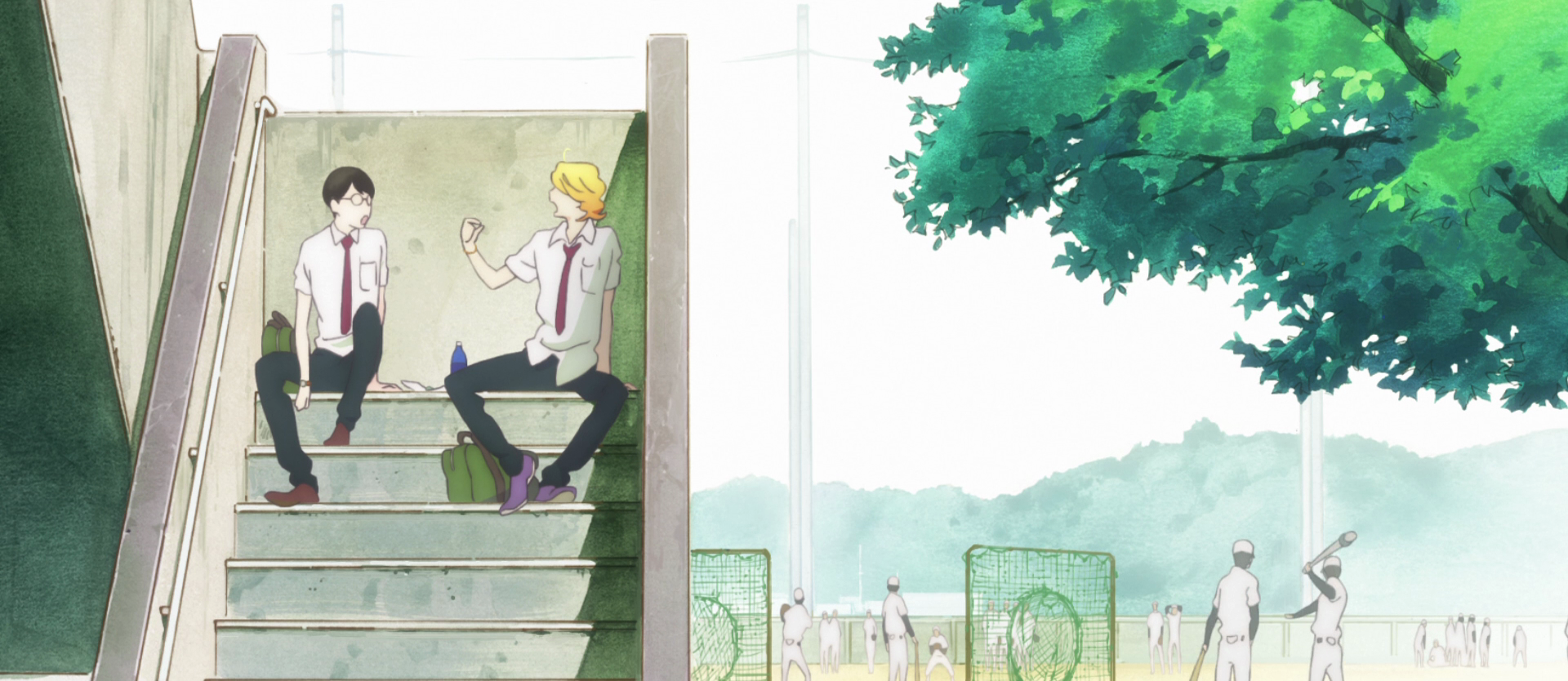

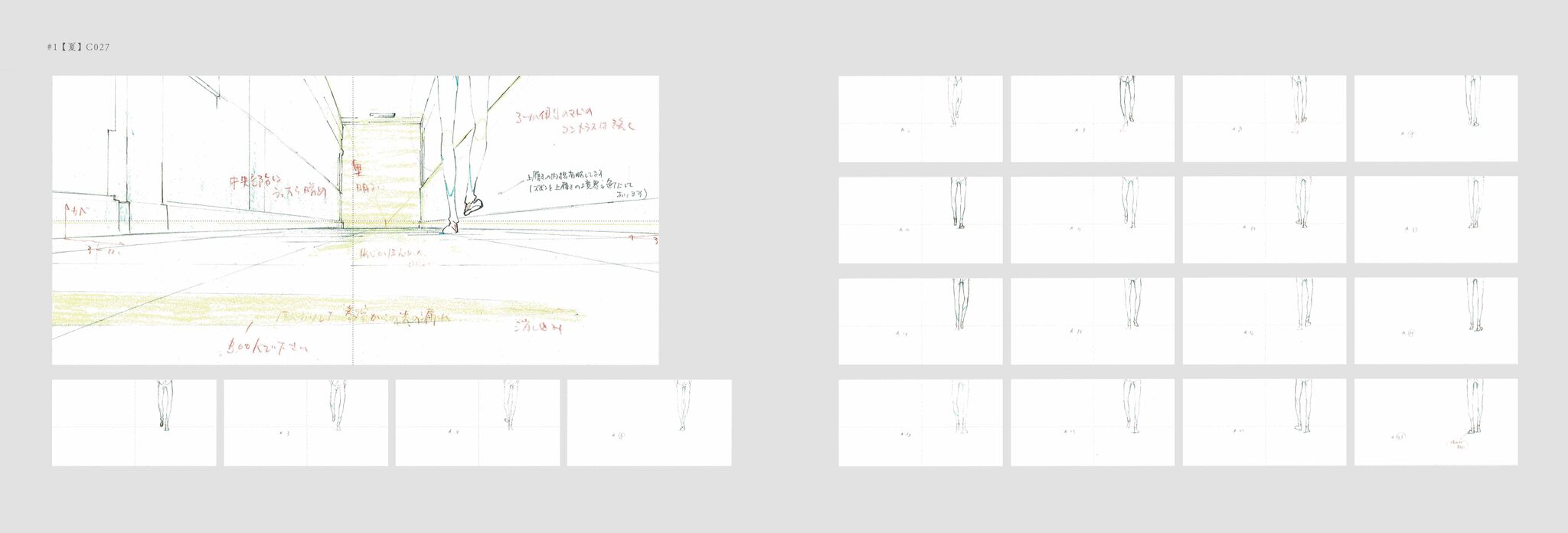
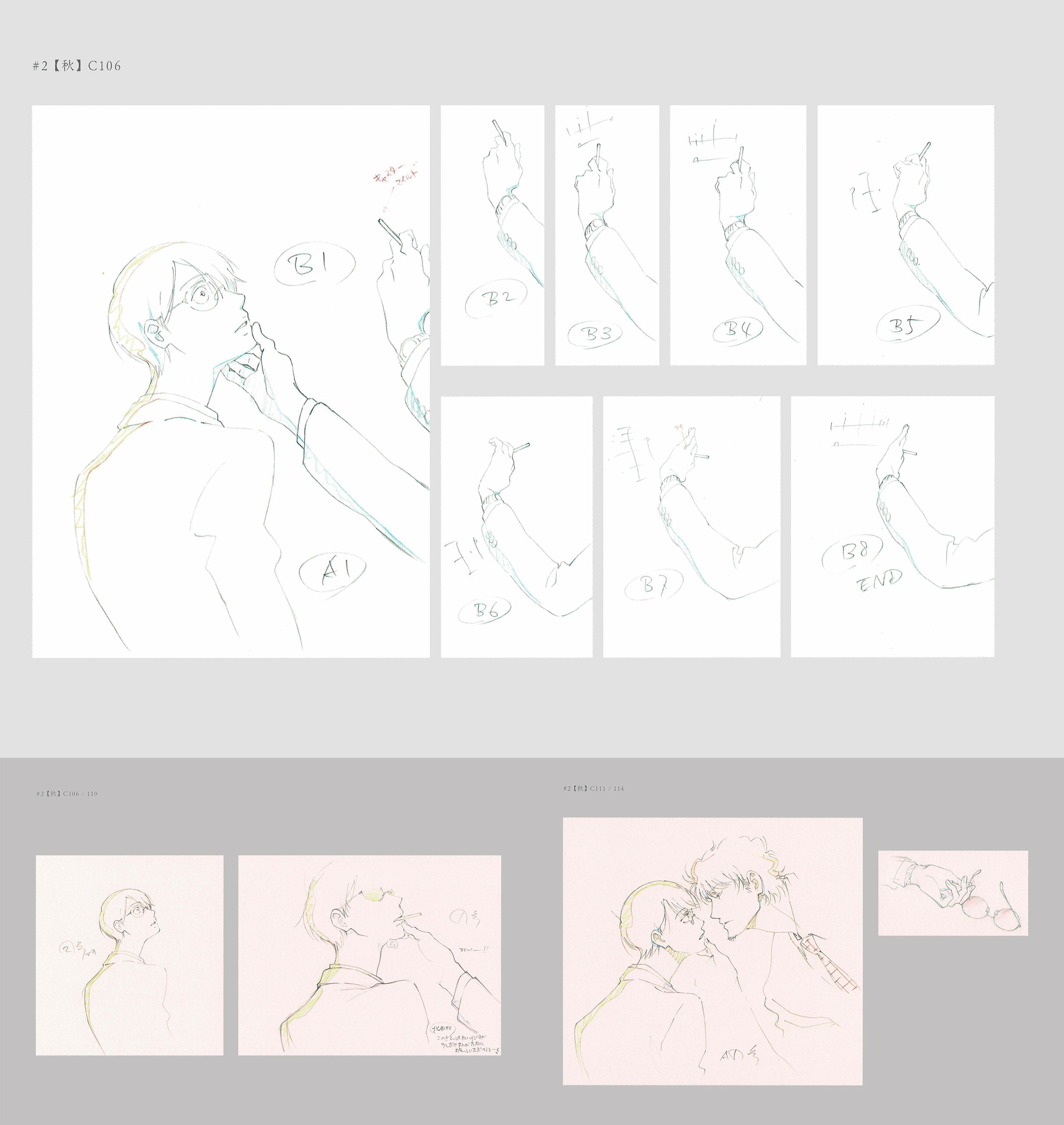


What a lengthy conversation. Thanks for the translation!
Thank you for this.